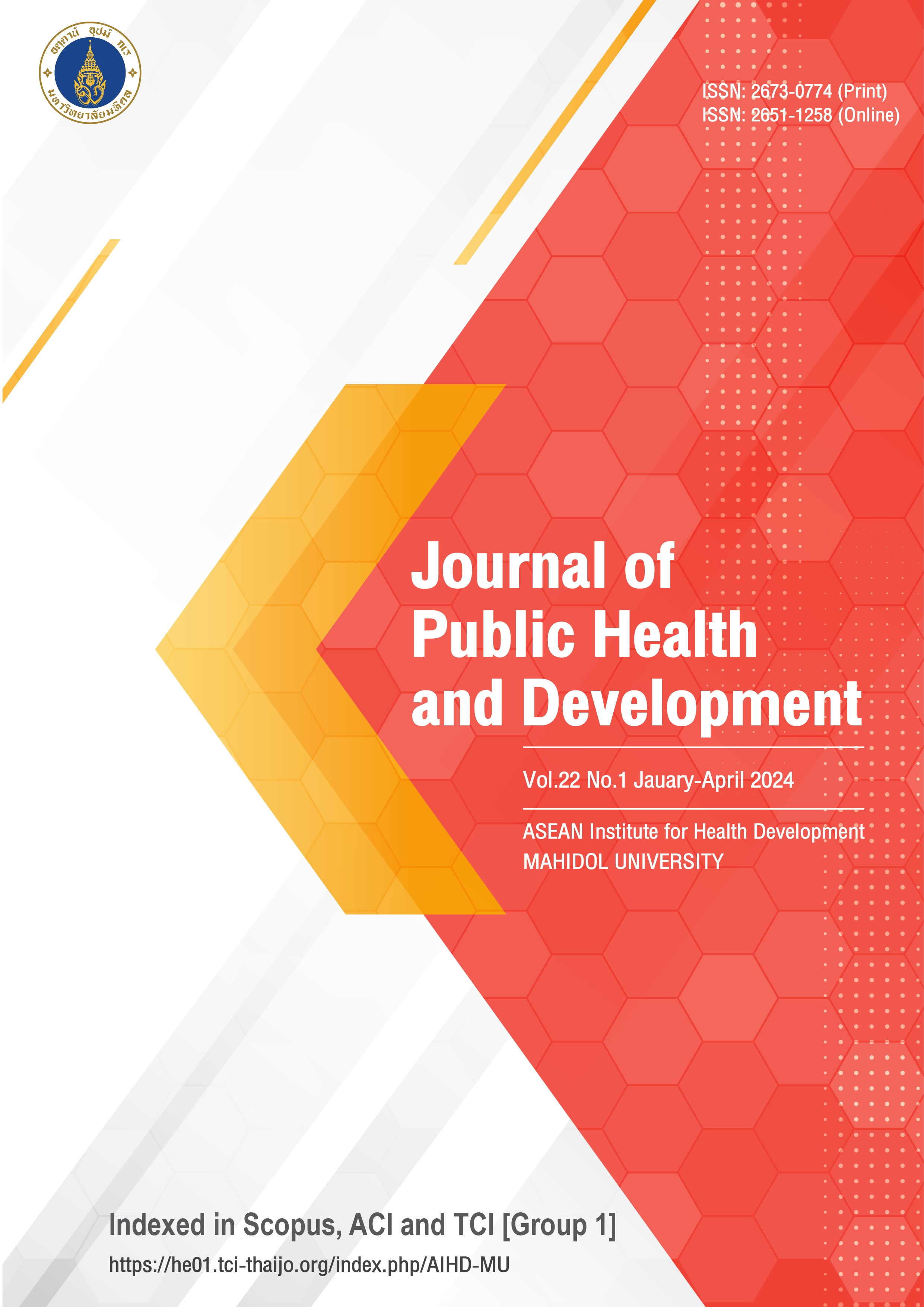Perception, attitudes and expectations among people toward emergency medical services system in Samut Songkhram Province, Thailand 10.55131/jphd/2024/220101
Main Article Content
Abstract
The emergency medical service system is a pre-hospital medical service that effectively helps reduce the severity of emergencies and mortality rates before transferring patients to the hospital. This cross-sectional study investigated people's perceptions, attitudes, and expectations toward the emergency medical services system and aimed to find the relationship between the perceptions, attitudes, and expectations toward the emergency medical services system in Samut Songkhram province, Thailand. The samples consisted of 491 individuals who were selected using a multi-stage sampling method. Data were collected through a self-administered questionnaire and analyzed using linear regression analysis to identify correlations. Results revealed that most participants demonstrated a good overall perception of the use of the emergency medical service system (M = 2.46, SD = 0.27), a good attitude towards the emergency medical service system (M = 2.40, SD = 0.23), and a high level of expectation towards the emergency medical service system (M = 2.85, SD = 0.25). Perception of the use of emergency medical services and attitude towards the emergency medical service system showed positive correlation with expectation towards the emergency medical service system, with R2 = 0.23 (p-value < 0.05). These findings can be used to plan and develop strategies for improving the utilization of emergency medical services, ensuring that the public is informed, understands, and accesses the emergency medical service system correctly and effectively.
Article Details

This work is licensed under a Creative Commons Attribution-NonCommercial-NoDerivatives 4.0 International License.
References
Strategy and Planning Division. Summary of sickness report 2020 [Internet]. Nonthaburi: Office of the Permanent Secretary Ministry of Public Health; 2020 [cited 2022 Nov 23]. Available from: https://bps.moph.go.th/
World Health Organization. Noncommunicable diseases [Internet]. Geneva: United Nations agency; 2021 [cited 2022 Nov 23]. Available from: https://www.who.int/health-topics/ noncommunicable-diseases#tab=tab_1
SukPhaibun U, et al. The satisfaction of clients toward emergency medical service system of Rangsit City Municipal, Pathumthani Province. JNMC. 2016;4(1): 417-25.
National Institute for Emergency Medicine. Situations and Trends in Health and Emergency Medicine (Global and Thailand) [Internet]. Nonthaburi: Ministry of Public Health; 2022 [cited 2022 Dec 2]. Available from: https://www.niems.go.th/1/ UploadAttachFile/2022/EBook/414764_20220208161448.pdf
Sirisamutr T, Doungthipsirikul S, Chuensamrong P, Wachiradilok P. Research report: Research to Development the quality of the emergency medical service system to the new normal (EMS New Normal) [Internet]. Nonthaburi: National Institute for Emergency Medicine; 2022 [cited 2022 Dec 5]. Available from: https://www.niems.go.th/1/UploadAttachFile/2022/EBook/416748_20221108154200.pdf
Department of Health. Health Population Database [Internet]. Nonthaburi: Ministry of Public Health; 2023 [cited 2023 Jan 10]. Available from: http://dashboard.anamai.moph. go.th/population/popall/changwat?year=2023&cw=75
HDC dashboard Samut Songkhram Provincial Health Office. Accidents and emergency prevention and emergency medical services operation situation report Samut Songkhram Province [Internet]. Samut Songkhram: Samut Songkhram Provincial Health Office; 2023 [cited 2023 Jan 10]. Available from: https://skm.hdc.moph.go.th/hdc/ main/index.php
Venesoja A, Castrén M, Tella S, Lindström V. Patients' perceptions of safety in emergency medical services: an interview study. BMJ Open. 2020;10(10):e037488. doi: 10.1136/ bmjopen-2020-037488.
Surachit C. Perception and expectation of Emergency Medical Service Paknamlangsuan Hospital, Chumphon Province. Reg11med. 2017;31(2):271-8.
Phianpailoon P. Knowledge, attitude, and expectations of people toward emergency medical services in areas covered by Samkok Community Hospital [dissertation]. Pathum Thani: Thammasat University; 2019.
Klepacka M, Bakalarski P. Trust of society towards selected medical professions – doctors, nurses, paramedics. Crit.nCare Innov. 2018;1(8):1-10. doi: 10.32114/CCI.2018.1.2.1.10
Pochaisan O, Pattanarattanamolee R, Pongphuttha W, Chadbunchachai W, Nakahara S. Development of an emergency medical services system in Thailand: Roles of the universal health coverage and the national lead agency. Emerg Med Australas. 2021;33(4):756-8. doi: 10.1111/1742-6723.13794
Songsin N, Boonchieng W, Intawong K. The relationships between perception, attitudes, and expectations of monks on the use of emergency service systems in Chiang Mai Province. JHR. 2021;15(1):119-30.
Cochran WG. Sample Techniques. New York: McGraw-Hill Book; 1985. p. 31.
Sirisamutr T, Ponsen K, Wachiradilok O. Knowledge, perspective, and reasons of not-calling emergency medical services in Thailand. JHSR. 2018;12(4):68-80.
Khuntongkaew S. The study of Factors Related to Use Emergency Medical Services, Ratchaburi Province. JPCN. 2019;2(1):30-44.
Jatawatana W. Attitude of village Health Volunteer about Emergency Medical Service Case Study: Namomdistri, Songkhla Province. Maharaj Nakhon Si Thammarat Med J. 2021;4(2):41-52.
Songsin N, Boonchieng W. Problems and Obstacle to the Use of Emergency Service Systems of Monks in Northern Provinces of Thailand. HCU J. 2021;25(2):247-57.
Armatpundit T. Factors Influencing Utilization of Emergency Medical Service of Severity and Critical Illness Patients in Ubonrathchathani Province. JHS. 2017; 26(5):884-95.
Møller TP, Jensen HG, Viereck S, Lippert F, Østergaaard D. Medical dispatchers' perception of the interaction with the caller during emergency calls - a qualitative study. Scand J Trauma Resusc Emerg Med. 2021;29(1):45. doi: 10.1186/s13049-021-00860-y.
AlRazeeni DM. Knowledge and Attitude of Saudi Emergency Medical Services Students Regarding Pain Management: A Cross-Sectional Study. Inquiry. 2021;58:469580211056043. doi: 10.1177/00469580211056043






